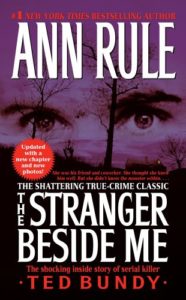 Most people on the planet know the “Ted Bundy” story (unfortunately). That alone does not make Ann Rule’s The Stranger Beside Me a true crime classic, though she relates the details of the case in her typically clear, well-told storytelling style. She’s one of the best in the biz, and this book illustrates the reason why. And on her telling of Bundy’s story alone, this would be a great true crime book. What takes it to the next level and makes it unique is the friendship she had with Ted Bundy, far pre-dating his notoriety. It’s her own change of feelings and attempt to understand what happened that make this book a standout.
Most people on the planet know the “Ted Bundy” story (unfortunately). That alone does not make Ann Rule’s The Stranger Beside Me a true crime classic, though she relates the details of the case in her typically clear, well-told storytelling style. She’s one of the best in the biz, and this book illustrates the reason why. And on her telling of Bundy’s story alone, this would be a great true crime book. What takes it to the next level and makes it unique is the friendship she had with Ted Bundy, far pre-dating his notoriety. It’s her own change of feelings and attempt to understand what happened that make this book a standout.
Rule died about a year ago, a death I greeted with extreme regret because though I don’t read much true crime, her books were a never-miss for me. She illustrated the blackest of human hearts, while staunchly standing up for the victims of whatever crimes she was writing about. She was also a staunch police ally – something that became a trope in her later books – but The Stranger Beside Me illustrates why she was such a police ally. Later in her career, one of her subjects had begged her family to have Ann Rule write about her eventual murder (Too Late to Say Goodbye) because she knew Rule would tell her story fairly.
A former police officer herself, Ann scrabbled together an early career writing, as Andy Stack, for True Detective magazine. She was doing this when she met Ted Bundy. They met as they manned a crisis hotline in Seattle together. She was later assigned the Lake Sammamish “Ted” murders, never in a million years connecting her friend Ted with the killer she was writing about. Writing about her friend Ted Bundy ironically became her ticket to the big time. She maintained a correspondence with him until his execution.
The slow transformation chronicled in the book as she slowly realizes her friend is guilty of horrible crimes comes to a head when she and other reporters were allowed, during one of Ted’s trials, to see photographic evidence of what he had done. She threw up. Never in her other books did she give any of the killers she chronicles much benefit of the doubt, and indeed, seldom do they deserve it, but in this book she makes a mighty attempt to understand the kind of sociopathic mind that Ted Bundy possessed.
The afterword to the book, written after Bundy’s Florida trial and sentence of execution, follows his numerous appeals as well as his eventual last-ditch confession and death. Rule felt Ted should have been studied and learned from, and she may have been right, but the state of Florida and its citizens were avenging some very terrible murders. However you feel about the death penalty, Ted Bundy pushes the boundaries.
For Ann Rule, it was still the execution of a one-time friend. Her anguish is obvious and real – anguish at what he’d done, at the waste of his potential, and the eventual waste of his life. An interest in the human heart and mind makes this book a must read, if a painful one, and places Ann Rule at the very top of the true crime genre. It’s a maligned genre but it’s one that tells the dark and sometimes sadly banal side of human evil. It’s something most of us find uncomfortable to think about, but it’s as real as the anguish Ann Rule relates so well. She is very much missed, one year after her death.